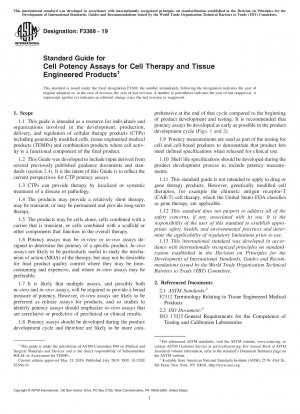ASTM F3368-19
Standard Guide for Cell Potency Assays for Cell Therapy and Tissue Engineered Products
- Standard No.
- ASTM F3368-19
- Release Date
- 2019
- Published By
- American Society for Testing and Materials (ASTM)
- Latest
- ASTM F3368-19
- Scope
- 1.1 This guide is intended as a resource for individuals and organizations involved in the development, production, delivery, and regulation of cellular therapy products (CTPs) including genetically modified cells, tissue engineered medical products (TEMPs) and combination products where cell activity is a functional component of the final product. 1.2 This Guide was developed to include input derived from several previously published guidance documents and standards (section 2.4). It is the intent of this Guide is to reflect the current perspectives for CTP potency assays. 1.3 CTPs can provide therapy by localized or systemic treatment of a disease or pathology. 1.4 The products may provide a relatively short therapy, may be transient, or may be permanent and provide long-term therapy. 1.5 The products may be cells alone, cells combined with a carrier that is transient, or cells combined with a scaffold or other components that function in the overall therapy. 1.6 Potency assays may be in-vitro or in-vivo assays designed to determine the potency of a specific product. In-vivo assays are likely to be particularly useful to study the mechanism of action (MOA) of the therapy, but may not be desirable for final product quality control where they may be timeconsuming and expensive, and where in-vitro assays may be preferable. 1.7 It is likely that multiple assays, and possibly both in-vitro and in-vivo assays, will be required to provide a broad measure of potency. However, in-vitro assays are likely to be preferred as release assays for products, and so studies to identify potency assays should emphasize in-vitro assays that are correlative or predictive of preclinical or clinical results. 1.8 Potency assays should be developed during the product development cycle and therefore are likely to be more comprehensive at the end of that cycle compared to the beginning of product development and testing. It is recommended that potency assays be developed as early as possible in the product development cycle (Figs. 1 and 2). 1.9 Potency measurements are used as part of the testing for cell and cell-based products to demonstrate that product lots meet defined specifications when released for clinical use. 1.10 Shelf life specifications should be developed during the product development process to include potency measurements. 1.11 This standard guide is not intended to apply to drug or gene therapy products. However, genetically modified cell therapies, for example the chimeric antigen receptor-T (CAR-T) cell therapy, which the United States FDA classifies as gene therapy, are applicable. 1.12 This standard does not purport to address all of the safety concerns, if any, associated with its use. It is the responsibility of the user of this standard to establish appropriate safety, health, and environmental practices and determine the applicability of regulatory limitations prior to use. 1.13 This international standard was developed in accordance with internationally recognized principles on standardization established in the Decision on Principles for the Development of International Standards, Guides and Recommendations issued by the World Trade Organization Technical Barriers to Trade (TBT) Committee.
ASTM F3368-19 Referenced Document
- ASTM F2312 Standard Terminology Relating to Tissue Engineered Medical Products*, 2020-02-01 Update
- ISO/IEC 17025 General requirements for the competence of testing and calibration laboratories [Standard in French]
ASTM F3368-19 history
- 2019 ASTM F3368-19 Standard Guide for Cell Potency Assays for Cell Therapy and Tissue Engineered Products
